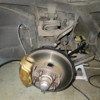The advantage to this mod is:
- No need to bleed each front brake piston separately
- Eliminated multiple fittings and connections
- Cleaner Look
- Adapts easily to standard A/N-3 fittings
* * Please don't say I should buy a new brake kit from one of the vendors - maybe I should, but that's not what this thread is about * *
The calipers have been modified by drilling a long hole through the casting as shown in the picture below. The hole intersects both piston bores, and allows a fluid passage between them. On this first set, the long holes are filled by setscrews, cemented in place with a JB Weld-like substance.
Both caliper halves are drilled, so that both pistons on each side are connected.
In addition, on this set, the lower bleeder screw hole was drilled out to a standard thread, and an A/N-3 brake adapter was installed.
I cleaned up these calipers, painted and rebuilt them, but I must have missed something in the O-ring groove, because one of the piston seals was leaking. So I had to have my second set modified.
Here is a picture showing the crossdrilling location, and setscrew cemented in place. Note the A/N Fittings.
Also note that on this set, both of the manifold inputs are plugged with standard metric 10x1.25 bolts, with copper washers.



